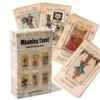The Influence of Roger Bacon and Duns Scotus
During the reign of Edward I (1272-1307), the medieval Church played a pivotal role in shaping education and learning in England. This era, marked by both political consolidation and cultural transformation, witnessed significant intellectual activity largely fostered by the Church. Key figures such as Roger Bacon and Duns Scotus emerged as prominent scholars, embodying the Church’s influence on education.
The Church as the Epicenter of Learning
The medieval Church was the cornerstone of education during Edward I’s time. Monasteries, cathedrals, and collegiate churches were the primary institutions where learning took place. Monastic schools provided basic education to young boys, focusing on religious instruction, Latin literacy, and the trivium (grammar, rhetoric, and logic). These schools were often the first point of contact with structured learning for many children, especially those destined for a life in the clergy.
Cathedral schools were more advanced than monastic schools and catered to older boys and young men. These schools were attached to cathedrals and were run by the clergy. They offered more comprehensive instruction in the liberal arts, which included the quadrivium (arithmetic, geometry, music, and astronomy) in addition to the trivium. The Church’s commitment to education was not solely for the preparation of clergy but also to create educated individuals who could serve in various capacities within society, including as scribes, administrators, and scholars.
With the foundation of universities, such as Oxford and Cambridge, the Church’s role in education expanded even further. These universities became centers of higher learning where students could pursue advanced studies in theology, law, medicine, and the arts. The Church’s influence ensured that these institutions maintained a curriculum that aligned with Christian doctrine, while also encouraging intellectual exploration and debate.
Roger Bacon: The Friar and Philosopher

Roger Bacon (c. 1219-1292), an English philosopher and Franciscan friar, was one of the most remarkable scholars of the medieval period. Known for his advocacy of the empirical method, Bacon emphasized observation and experimentation, challenging the dominant Scholastic method of his time. His works, such as “Opus Majus,” “Opus Minus,” and “Opus Tertium,” covered various fields including mathematics, optics, and alchemy.
Bacon’s insistence on empirical evidence was groundbreaking. He believed that education should be based on direct observation of the world, rather than solely on the authority of ancient texts. This perspective foreshadowed the scientific method, positioning Bacon as a precursor to the modern scientific revolution. His work in optics, for example, laid the foundation for future studies in the field. He conducted experiments with lenses and mirrors, significantly advancing the understanding of light and vision.
Despite his innovative approach, Bacon’s ideas often put him at odds with the Church authorities. His critical stance towards the Scholastic tradition, which relied heavily on Aristotle and other classical authors, was viewed with suspicion. Bacon argued that many of the accepted teachings were flawed and called for a reform of the educational system. His outspoken nature and controversial ideas eventually led to his imprisonment by the Church, highlighting the tension between innovation and orthodoxy in medieval education.
Duns Scotus: The Subtle Doctor
John Duns Scotus (c. 1266-1308), a contemporary of Edward I, was another influential figure whose work significantly impacted medieval thought. Known as the “Subtle Doctor” due to his intricate and precise philosophical arguments, Scotus was a leading Franciscan theologian and philosopher. His contributions to metaphysics, ethics, and theology were profound.
Scotus is best known for his defense of the Immaculate Conception and his complex arguments about the nature of being and existence. He developed the concept of “haecceity,” or “thisness,” to explain the uniqueness of individual entities, which was a significant departure from the prevailing Aristotelian views. His work on the Immaculate Conception was groundbreaking, arguing that Mary, the mother of Jesus, was conceived without original sin. This doctrine would later become a core belief of the Roman Catholic Church.

Scotus’s philosophy emphasized the importance of will and love in human actions, contrasting with the more intellect-centered views of his contemporaries. His arguments were characterized by their logical rigor and depth, earning him the title of the “Subtle Doctor.” Despite the complexity of his work, Scotus’s emphasis on reason and logic demonstrated the Church’s role in nurturing intellectual rigor and scholastic debate. His ideas influenced later philosophers and theologians, leaving a lasting impact on Christian thought.
The Legacy of Church-Sponsored Education
The Church’s influence on education during Edward I’s reign was multifaceted. It provided the infrastructure for learning through monastic and cathedral schools, promoted intellectual inquiry, and supported scholars like Bacon and Scotus. The tension between traditional Scholastic methods and emerging empirical approaches exemplified by Bacon highlighted the dynamic nature of medieval scholarship.
Moreover, the establishment of universities, such as Oxford and Cambridge, further underscored the Church’s commitment to higher learning. These institutions became the breeding grounds for theological and philosophical debates, producing scholars who would shape the intellectual landscape of Europe for centuries. The curriculum at these universities was deeply rooted in Christian doctrine, yet they also offered a space for questioning and expanding upon existing knowledge.
The Church’s sponsorship of education had a lasting legacy. It helped preserve and transmit classical knowledge through the turbulent times of the early Middle Ages and fostered an environment where intellectual pursuits were valued. The intellectual achievements of this period laid the groundwork for the Renaissance and the eventual rise of modern science and philosophy.
Conclusion
In conclusion, the medieval Church was the driving force behind education and learning during Edward I’s reign. Figures like Roger Bacon and Duns Scotus, with their groundbreaking work, exemplified the Church’s complex relationship with knowledge and inquiry. While the Church maintained control over education, it also fostered an environment where intellectual exploration could flourish. This dual role ensured that the medieval period remained a vibrant and intellectually stimulating era, setting the stage for the Renaissance and the eventual rise of modern science and philosophy.
By nurturing institutions of learning and supporting scholars, the Church played an essential role in the development of Western intellectual tradition. The contributions of Bacon and Scotus illustrate the rich tapestry of medieval thought, blending faith and reason in a way that would shape the course of history. The Church’s role in education during this period was not just about maintaining religious orthodoxy but also about promoting a broader intellectual culture that has left an indelible mark on the world.





